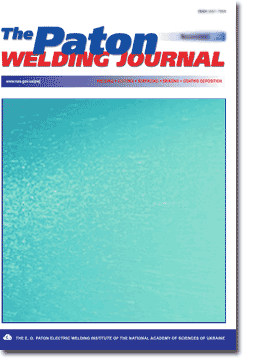| 2009 №01 (01) | 2009 №01 (03) |

TPWJ, 2009, #1, 6-11 pages
APPLICATION OF MATHEMATICAL MODELLING IN THERMAL STRAIGHTENING OF SHIPBUILDING PANELS
Journal The Paton Welding Journal
Publisher International Association «Welding»
ISSN 0957-798X (print)
Issue № 1, 2009 (January)
Pages 6-11
Authors
O.V. MAKHNENKO1, A.F. MUZHICHENKO1 and P. SEYFFARTH2
1E.O. Paton Electric Welding Institute, NASU, Kiev, Ukraine
2IMG GmbH, Rostock, Germany
Abstract
Described is an example of application of mathematical modelling for investigation of the efficiency of the process of thermal straightening of shipbuilding panels, based on the approach of a combined use of the general thermoplasticity method and approximate shrinkage function method. It is shown that the approach suggested is particularly efficient for prediction of general distortions of large-size spatial structures in the case of a large number of welds contained in them or of local heatings used for straightening. The results of experiments on thermal straightening of shipbuilding panels with buckling distortions have been analysed, and objective factors limiting the efficiency of this technological operation, especially with large thicknesses of the panels, have been revealed.
Keywords: thin-sheet welded structures, shipbuilding panels, welding distortions, thermal straightening, mathematical modelling, thermoplasticity method, shrinkage function method
Received: 21.03.08
Published: 28.01.09
References
1. Paton, E.O., Gorbunov, B.N., Bernshtejn, D.I. et al. (1936) Shrinkage stresses in welding of cylindrical vessels. Avtogennoe Delo, 5/6.
2. Podstrigach, Ya.S., Plyatsko, G.V., Osadchuk, V.A. (1971) On determination of welding residual stresses in cylindrical shells. Avtomatich. Svarka, 3, 50-58.
3. Ueda, Y., Yuan, M.G. (1991) The characteristics of the source of welding residual stress (inherent strain) and its application to measurement and prediction. Transact. of JWRI, 20(2), 119-127.
4. Makhnenko, V.I., Lobanov, L.M., Makhnenko, O.V. et al. (1991) Prediction of general deformations of welded units by using the database on transverse and longitudinal shrinkage, and angular deformations of appropriate samples. Avtomatich. Svarka, 10, 1-5.
5. Lobanov, L.M., Makhnenko, O.V., Sayfferth, P. (1997) Design prediction of welding deformations in production of flat sections with the purpose of decrease of fitting operations. Ibid., 1, 21-24.
6. Makhnenko, V.I., Lobanov, L.M., Makhnenko, O.V. (1998) Problem-oriented software package for prediction of welding stresses and distortions with reference to the solution of various questions of formation. Weldability and accuracy of welded structures. IIW Doc. X/XV-RSD.
7. Luo, Y., Deng, D., Xie, L. et al. (2004) Prediction of deformation for large welded structures based on inherent strain. Transact. of JWRI, 33(1), 65-70.
8. Liang, W., Shinji, S., Tejima, M. et al. (2004) Measurement of inherent deformations in typical weld joints using inverse analysis. Pt 1: Inherent deformation of bead on welding. Ibid., 33(1), 45-51.
9. Kuzminov, S.A. (1974) Welding deformations of ship hull structures. Leningrad: Sudostroenie.
10. Vinokurov, V.A., Grigoriants, A.G. (1984) Theory of welding strains and stresses. Moscow: Mashinostroenie.
Suggested Citation
O.V. MAKHNENKO1, A.F. MUZHICHENKO1 and P. SEYFFARTH2 (2009) APPLICATION OF MATHEMATICAL MODELLING IN THERMAL STRAIGHTENING OF SHIPBUILDING PANELS. The Paton Welding J., 01, 6-11.The cost of subscription/purchase order journals or individual articles
| Journal/Currency | Annual Set | 1 issue printed |
1 issue |
one article |
| TPWJ/USD | 384 $ | 32 $ | 26 $ | 13 $ |
| TPWJ/EUR | 348 € | 29 € | 24 € | 12 € |
| TPWJ/UAH | 7200 UAH | 600 UAH | 600 UAH | 280 UAH |
| AS/UAH | 1800 UAH | 300 UAH | 300 UAH | 150 UAH |
| AS/USD | 192 $ | 32 $ | 26 $ | 13 $ |
| AS/EUR | 180 € | 30 € | 25 € | 12 € |
| SEM/UAH | 1200 UAH | 300 UAH | 300 UAH | 150 UAH |
| SEM/USD | 128 $ | 32 $ | 26 $ | 13 $ |
| SEM/EUR | 120 € | 30 € | 25 € | 12 € |
| TDNK/UAH | 1200 UAH | 300 UAH | 300 UAH | 150 UAH |
| TDNK/USD | 128 $ | 32 $ | 26 $ | 13 $ |
| TDNK/EUR | 120 € | 30 € | 25 € | 15 € |
AS = «Automatic Welding» - 6 issues per year;
TPWJ = «PATON WELDING JOURNAL» - 12 issues per year;
SEM = «Electrometallurgy Today» - 4 issues per year;
TDNK = «Technical Diagnostics and Non-Destructive Testing» - 4 issues per year.


